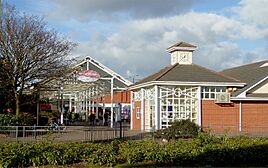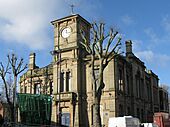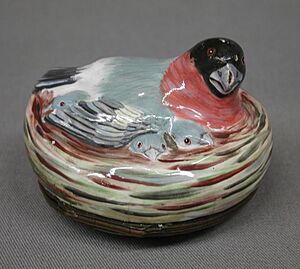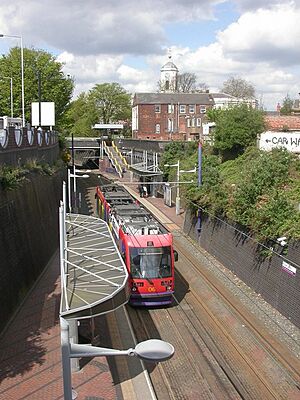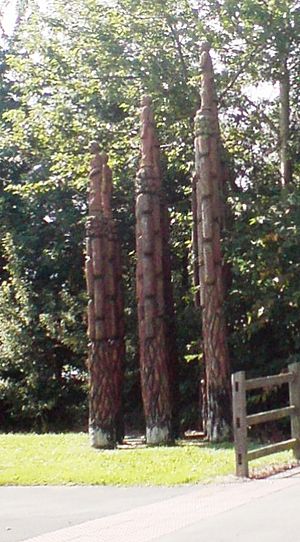Bilston facts for kids
Quick facts for kids Bilston |
|
|---|---|
|
Top: Bilston Market entrance. Lower: St Leonard's Church, Town Hall |
|
| Population | 25,576 (2011.Wards) |
| OS grid reference | SO951964 |
| Metropolitan borough | |
| Metropolitan county | |
| Region | |
| Country | England |
| Sovereign state | United Kingdom |
| Post town | BILSTON |
| Postcode district | WV14 |
| Dialling code | 01902 |
| Police | West Midlands |
| Fire | West Midlands |
| Ambulance | West Midlands |
| EU Parliament | West Midlands |
| UK Parliament |
|
Bilston is a busy market town in the City of Wolverhampton. It is located in the West Midlands, England. The town is part of the Black Country. It is about 2.5 miles (4 km) south-east of Wolverhampton city centre. Bilston is also close to the borders of Sandwell and Walsall.
For a long time, Bilston was known for making enamel items. This started in the mid-1600s. It was also a big area for coal and iron mining. During Victorian times, iron works were very important. Later, the town became a centre for making steel. In 2021, about 34,639 people lived in Bilston.
Contents
History of Bilston
Bilston was first mentioned way back in AD 985. It was called Bilsatena then. This was when Wolverhampton was given to a person named Wulfrun. Later, in 996, it was called Bilsetnatun. This name might mean "the settlement of the people of the ridge." It also appears in the Domesday Book as a village called Billestune.
Historically, Bilston was in Staffordshire. It was mostly a farming area. But in the 1800s, many factories and coal mines were built. This changed the town a lot.
In 1866, Bilston became a civil parish. This meant it had its own local government. The Bilston Urban District Council was set up in 1894. In 1933, Bilston became a municipal borough, which is a type of town council. Between 1920 and 1966, the council built many new houses. They replaced older, smaller homes.
On April 1, 1966, the Borough of Bilston was joined with other areas. Most of it became part of Wolverhampton. Some parts went to Walsall and West Bromwich. In 1961, about 33,067 people lived in Bilston.
Bilston Town Hall was built in 1872. It has been made new again and is now open. It was empty for over ten years. Now, it is a place for events, meetings, and shows.
Bilston lost its passenger railway station in 1972. But goods trains still used the tracks for another ten years. The town's new bus station opened in October 1991. It connects with the West Midlands Metro tram station, which opened in May 1999.
The very large British Steel Corporation factory closed in 1979. This was after 199 years of making steel there. Nearly 2,000 jobs were lost. Some of the land was used for new houses. A large DIY store opened there in 1993. Another steel factory, GKN, also closed in 1989.
Work on the Black Country Route road started in the mid-1980s. The last part was finished in July 1995. This road gave Bilston a direct link to Dudley, Walsall, and the M5 Motorway. The Black Country Spine Road also opened. This made it easier to get to West Bromwich and Birmingham.
New buildings in Bilston in the 2000s include the South Wolverhampton and Bilston Academy. The Bert Williams Leisure Centre is next to it. These are part of a plan to build over 1,000 new homes in the town.
St Leonard's Church
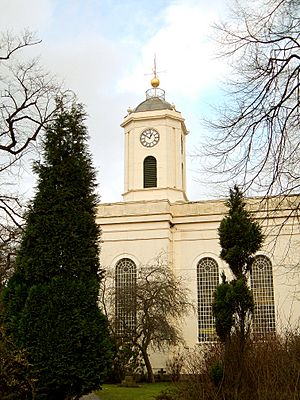
People have worshipped in Bilston since 1090. In 1458, a chapel was replaced by St Leonard's Chantry. A third church was built in 1733. The church you see today was rebuilt in 1825–26. It was designed by Francis Godwin. Some older stone from the 1300s or 1400s can still be seen inside the tower. The church was changed again in 1882–83 by Ewan Christian.
The church has a font from 1673. This might have come from the older church. The church is painted white inside and out. Its square tower is unusual because it looks octagonal. It has a dome, a golden globe, and a weather vane on top.
Industry in Bilston
From the mid-1700s, Bilston became famous for enamelling. This is a craft where colourful glass is melted onto metal. People made decorative boxes like patch-boxes and scent boxes.
The Birmingham Canal opened west of the town in 1770. This led to more factories and industries. The first blast furnaces for making iron were built near the canal by 1780.
The Industrial Revolution completely changed Bilston. In 1800, it was mostly farms. By 1900, it was a busy town. It had many factories and coalmines. There were also lots of houses for the workers. It was said that the Bilston coal mines had an evil spirit. So, miners brought in a local exorcist called The White Rabbit.
Six new blast furnaces were built between 1866 and 1883. Five of these made nearly 25,000 tons of steel each year. This was at what became known as Bilston Steel Works. The first electric blast furnaces opened there in 1907. In 1954, the "Elisabeth" blast furnace was built. It could make 275,000 tons of steel every year.
However, by the 1970s, the steel works was not making enough money. The government decided to close it. It closed on April 12, 1979. The "Elisabeth" furnace was taken down on October 5, 1980. Many people lost their jobs. A old railway bridge that connected parts of the steelworks still stands over the canal.
Industry was still strong between the two World Wars. But many houses were old and not good enough. So, in the 1920s and 1930s, many old houses were pulled down. They were replaced with modern council houses.
People from Bilston
Many famous people have connections to Bilston:
- John Wilkinson, known as "king of the ironmasters," built a blast furnace in Bilston in 1748.
- Richard Salter started making the first spring scales in Britain in Bilston in the late 1760s.
- George T. Morgan was an engraver for the Royal Mint. He later designed the famous Morgan silver dollar in the USA.
- The poet Sir Henry Newbolt was born in Bilston. His brother, Sir Francis Newbolt, was also born there.
- Captain George Onions, a British soldier, was born in Bilston. He won the Victoria Cross in 1918.
- Hugh Walters, a science fiction writer, lived his whole life in Bilston.
- Bert (The Cat) Williams was a famous goalkeeper. He played for Wolverhampton Wanderers and the England squad. A sports centre in Bilston is named after him.
- David Daker, born in Bilston in 1935, is an actor. He was in TV shows like Z-Cars and Porridge.
- Sir Bruce Forsyth, a famous TV presenter, first performed on stage in Bilston when he was 14.
- Reg Lewis scored both goals for Arsenal in the 1950 FA Cup final. He was born in Bilston.
- James Fleet, born in Bilston in 1952, is an actor. He is known for Four Weddings and a Funeral and The Vicar of Dibley.
- Don Powell, the drummer for the band Slade, was born in Bilston.
- Steve Woolam was one of the first members of the Electric Light Orchestra. He was born in Bilston.
Transport in Bilston
Canals
The Birmingham Canal was built to serve towns like Bilston. It opened in parts between 1769 and 1772. Coal from Bilston was sent to Birmingham by canal. Later, a branch was also built from the Walsall Canal to Bilston. This branch closed in 1953.
Railways
Bilston had a railway station from 1850 to 1972. After 1972, passenger trains stopped running. The railway line through Bilston was mostly closed within ten years. There was also another station, Bilston West, which is now closed. The last part of the railway line closed in 1992.
Trams
Bilston has three West Midlands Metro tram stops. These are Bilston Central, Loxdale, and The Crescent. The tram line runs between Wolverhampton and Birmingham. New tram lines to Stourbridge and Walsall are planned for the future.
Roads
A big road project in Bilston was the A463 Black Country Route. As more cars were used, roads in Bilston became very busy. In the 1960s, plans for a new motorway were made but not built. In the early 1980s, new plans for a dual carriageway were started. This road became the Black Country Route.
The first part of the road was finished in 1986. It was extended into Bilston town centre in 1990. Some buildings were taken down to make way for the road. The final part of the Black Country Route was finished in 1995. This helped traffic flow much better in and around Bilston.
Buses
Bilston Bus Station opened in 1991. It was updated in 2005. Buses run from the station to many places. These include Wolverhampton, Willenhall, Dudley, and Walsall. Buses also go to nearby areas like Ettingshall and Bradley.
Most bus services are run by National Express West Midlands. Other companies like Diamond West Midlands and Banga Bus also run services. Some services get help from Transport for West Midlands.
Arts and Culture in Bilston
At the Bilston end of the Black Country Route, you can see "Steel Columns." This is a group of wooden statues. They were designed by Robert Koenig. The statues are made from 15 pieces of sweet chestnut wood. They are up to 6 metres tall. The figures look like people from old Victorian photos of Bilston. The name "Steel Columns" reminds us of Bilston's history of making steel.
The Bilston Craft Gallery shows art and craft works from the 1700s. It also has a space for new art and crafts. The gallery offers workshops for families and children. School groups often visit too.
The artist William Harold Dudley was born in Bilston. Some of his paintings are in the Wolverhampton Art Gallery.
In the 1960s, the Bilston Carnival was a big event. It travelled along Wellington Road. It ended in Hickman Park. There was a fun fair, horse jumping, and live music. The park also had one of the tallest slides for children.
Media
Local news and TV shows for Bilston come from BBC West Midlands and ITV Central. TV signals are received from the Sutton Coldfield TV transmitter.
Local radio stations include BBC Radio WM, Heart West Midlands, and Smooth West Midlands. There are also Hits Radio Black Country & Shropshire and Greatest Hits Radio Birmingham & The West Midlands. WCR FM is a community radio station from nearby Wolverhampton.
The local newspaper for the town is the Express & Star.
Education in Bilston
Bilston has 15 primary schools. It also has two secondary schools: South Wolverhampton and Bilston Academy and Moseley Park School. Moseley Park School used to be Etheridge Secondary Modern and Bilston Boys' Grammar School.
Bilston had a special school called the Cholera Orphan School. It opened in 1833. This was after a serious outbreak of cholera. The disease left 450 children without parents in Bilston. The The Royal School, Wolverhampton has a similar history.
Population Facts
The word "demography" means studying populations. Here are some facts about the people living in Bilston from the 2021 Census.
| Bilston: Ethnicity: 2021 Census | |||||||||||||
| Ethnic group | Population | % | |||||||||||
|---|---|---|---|---|---|---|---|---|---|---|---|---|---|
| White | 22,792 | 65.8% | |||||||||||
| Asian or Asian British | 6,145 | 17.7% | |||||||||||
| Black or Black British | 2,962 | 8.6% | |||||||||||
| Mixed | 1,936 | 5.6% | |||||||||||
| Other Ethnic Group | 730 | 2.1% | |||||||||||
| Arab | 61 | 0.3% | |||||||||||
| Total | 34,639 | 100% | |||||||||||
Here are the religious groups in Bilston from the 2021 Census:
| Bilston: Religion: 2021 Census | |||||||||||||
| Religious | Population | % | |||||||||||
|---|---|---|---|---|---|---|---|---|---|---|---|---|---|
| Christian | 15,112 | 46.1% | |||||||||||
| No religion | 11,415 | 34.8% | |||||||||||
| Sikh | 3,384 | 10.3% | |||||||||||
| Hindu | 1,407 | 4.3% | |||||||||||
| Muslim | 834 | 2.5% | |||||||||||
| Other religion | 470 | 1.4% | |||||||||||
| Buddhist | 132 | 0.3% | |||||||||||
| Jewish | 15 | 0.1% | |||||||||||
| Total | 34,639 | 100% | |||||||||||
How Bilston is Governed
Bilston is divided into four local government areas called wards. These wards are part of Wolverhampton City Council. They are Bilston South, Bilston North, Ettingshall North, and Ettingshall South and Spring Vale.
From 1918 to 1974, Bilston had its own Member of Parliament (MP) for the Bilston parliamentary constituency. This area also included nearby Sedgley and Coseley. Now, Bilston is part of the Wolverhampton South East constituency.
See also
- In Spanish: Bilston para niños


